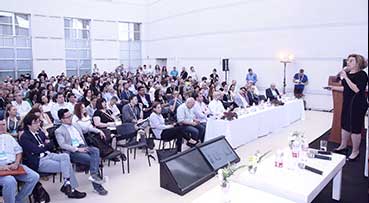For a while now these posts have been following the transition of work structures from 20th century hierarchical org structures to the more flexible, collaborative, networked work structures emerging in various organizations. To be clear, the end of hierarchy does not mean a flat world of work, nor does it mean the end of management. Even in a networked mode of work, where work is managed by the people themselves or through self managed teams, one might still observe those who take on leadership roles. And it does not matter if they were so appointed or simply grew into these roles by their own actions. These are, in most cases, not the senior leaders of the organizations, but the first line managers. And they are the ones who design culture on the ground.
In an article on HBR titled The Frontline Advantage, first line managers typically make up 50-60% of the managers in the organization, and their influence on the success or failure of the strategy is significant. They are the ones who come in day to day contact with employees and they are responsible for execution. They know more than senior management knows, what really happens on the ground with the product, the service, the customers. First line managers are central to any change. And in times of increased rate of change they are even more critical since we cannot afford people to simply go through the routines of the past. We have no choice but to construct organizations that know how to adapt themselves quickly to change and equip them with a culture that enables everyone to ask questions about how the work gets done. And who, if not first line managers, can create such an organization? The way first line managers perceive the organization, its leadership, its strategy, all that affects more than anything else its people, their motivation and engagement with the strategy, the goals, the work.
In preparation for a keynote at a First Line Manager training program, I spent time with a large organization going through change, where these managers play a central role in “how” this change will happen – will it be perceived as change from above, one that is pushed on the employees by management and leaves them to execute and complain? Or will they and their teams be part of the engine of change, realizing that together they can and will lead the organization to achieve its objectives successfully? This organization understood that first line managers were the key, and only through ensuring that they see their role and significant impact on the organization’s culture, only then will the organization move from the ground up, not from the top down, in the right direction. Only then, will they create the shift from the front lines.
Back in 1990, in his book Mintzberg on Management: Inside our Strange World of Organizations, Prof Henry Mintzberg reviewed the different roles of managers in an organization. Prof Mintzberg identified ten roles, grouped into three categories: Interpersonal, Informational and Decisional.
In the Interpersonal category, the manager provides information and ideas: they represent the organization to their employees, coach, supervise, instruct, connect between their people and other groups in the organization as well as outside of it. In this space managers are also figureheads, authority figures, leaders of their organizations, managing performance, communicating in and out and working their networks for the benefit of their organization.
The Informational category includes processing of information, including the search and presentation of relevant information to the team, from external and internal sources, covering both changes in the environment as well as in the organization. This also includes tracking the team’s activity, productivity, wellbeing and representing the team externally.
The Decisional category is where the manager is using information, which includes acting as a change agent and entrepreneur, solving problems, creating and enabling new ideas and implementing them, distributing resources, removing obstacles and dealing with disagreements. This includes negotiating solutions at various organizational levels.
At any given time, we change roles between these managerial capacities, according to circumstances and expectations.
It would be a mistake to assume only senior leadership sets strategy and defines plans for its execution. Think about it. If only leadership paves the road from vision to execution, that would make the organization an inanimate entity, like a machine, which does not move without programming. But people are not machines and organizations have their own purpose, their own innovative spark, a direction that starts from the bottom. And thus we circle back to first line managers. They have two options. The first, to define their role only as those who execute on what arrives from the top or, in other words, operate the organizational machine. The second option is to be managers, leaders. To ensure their people understand and are connected to the strategy and then bring their whole selves to the question how to make it happen. To bring ideas and initiatives from the bottom up as well as horizontally. To harness the energy of their groups to become part of the system, part of what moves it in the right direction.
In an HBR article The Execution Trap Roger Martin tries to change the way we distinguish between strategy and its application. Strategy is really a collection of choices we make under uncertainty and competition. Senior leadership, in setting the direction for the organization, chooses where to go, where to focus, with who, when. Then it sets the path for the next level to execute on those choices. But that process of so called execution is also a set of decisions about the “how” the strategy will be executed, decision which are not less complex or less important than the original setting of direction. And so, across all levels of the organization, whether we define it so or not, we make strategic choices within the scope of our level. Or, in other words, we use cascading processes of strategic choice nesting under the ones which already happened above us. The only real difference then between senior leadership and first line management, or even the employee for that matter, is the leeway or scope for our strategic choices.
According to this line of thought, all levels in the organization are really about strategy, not execution. And all levels have a range of decisions they have to own within their scope. In this kind of system, the role of each managerial layer is to explain the choices already made, the reasons behind them, and what is left open for the next layer to decide upon. And to support the next layer in its ability to make their decisions as well as re-evaluate decisions already made, if these don’t seem to be possible when reaching that level. And so, according to Roger Martin, we get a natural cascading of choices based on the scope each layer can take on but everyone, that is everyone, is part of a decision making process.
This is a completely different way to look at the role of first line managers. It assumes first line managers can redefine their role from one of executing decisions already made to identifying the scope of decisions they own and then enabling those. But more than that, first line managers are the ones who have visibility into those areas where decisions made above them do not meet the ground. And they have the power to surface these gaps, whether created by missing information or changing circumstances. In many cases we choose to stick to plans put in place, that we stop listening for the changing circumstances. First line managers have a crucial role listening, given the direction, and adapting the path accordingly.
Think about the word “guideline”. Too often we interpret them to mean rules. But guidelines are just that, lines to guide us if we choose to cross them, not barriers not to be crossed. Lines to help us know when we need to ask questions, check circumstances, downstream implications, the need for validation. But not rules, laws, not to be crossed under any circumstances, boxing us into our roles and definitions.
Innovation exists in many places around the organization. The question is, does it live in a system that knows how to disperse it or does the system suffocate it? That decision does not lie in the hands of senior management, but in reality, reality created by culture on the ground, that which is represented first and foremost by first line managers. Are they there to do what leadership tells them to do, other people’s plans? Or are they there to connect their teams to the “why we do what we do” and enable what their teams is capable of, which in turn will enable the organization’s direction?
The role of first line managers is to create the framework to enable their team to understand the big picture, the frame in which they can not only execute, but also create and influence. And that includes creating a culture of trust, one where employees can take risks, make decisions and innovate around products and services. This ability means the organization needs a strong set of values, one that will serve as a compass at points of uncertainty and new territory. So if you’re standing at the head of an organization or unit, ask yourself when was the last time you talked to your first line managers? And if you are first line managers, remember you are the organization, you are management and strategy is in your hands.

![large-AX1A2125-2[1] large-AX1A2125-2[1]](https://niritcohen.com/wp-content/uploads/elementor/thumbs/large-AX1A2125-21-pnzedcs72atx5aeurqytqdiihxixlq02re9mlz805s.jpg)






